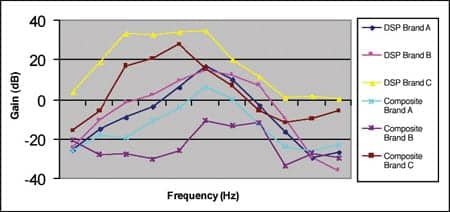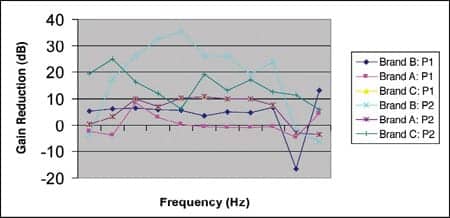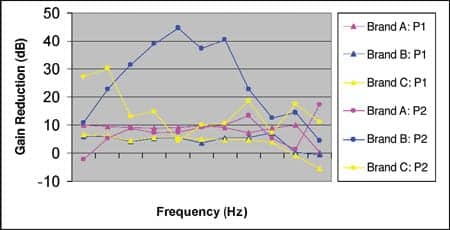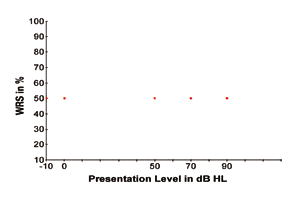The various DNR algorithms are not homogenous relative to gain
Digital noise reduction (DNR) refers to the ability of digital hearing aids to use envelope-detection to determine if signals are speech-like or noise-like and make gain adjustments accordingly. In most DNR systems, the input signal to the hearing aid is divided into multiple channels and the modulation activity is monitored in each channel. The acoustic basis for DNR algorithms is that speech has fewer modulations (Hz) with greater modulation depth (dB) than noise-like stimuli.1,2 Hence the goal of DNR algorithms is to separate speech-like stimuli from noise-like stimuli.
Many commercial digital hearing aids rely on DNR by determining if the input signal is modulated (speech-like) or unmodulated (noise-like). Speech is presumed to have large amplitude modulations, so if the modulation rate and depth of the speech-like signal are like those of speech in quiet, the signal is passed through the channel without any reduction. When steady-state noise in channels is detected by the hearing aid, then gain reduction is immediately applied to the steady signal in those frequency channels, typically proportional to the noise level.
While the within-channel signal-to-noise ratio (SNR) is typically unchanged following DNR, direct masking effects within channels or spread of masking to adjacent channels can be reduced.3 There is currently a need to use measurement tools that help to compare gain for unmodulated complex signals (that are steady-state or noise-like) versus modulated (speech or speech-like) stimuli to evaluate the efficacy of DNR in most high-end digital hearing aids.
Efficacy studies of DNR are generally sparse in literature, and, while effectiveness of DNR algorithms has been reported based on subjective listener preferences, it is difficult to quantify the benefit of actual DNR algorithms from these studies. In one DNR effectiveness study, listeners demonstrated a strong subjective preference for DNR algorithms, but a quantifiable improvement in speech perception ability was not observed.4 Other DNR effectiveness studies have reported increasing listening comfort under improved SNR conditions5,6 and even improved speech perception in noise when speech and noise sources are not spatially separated.7

|
| FIGURE 1. Effects of signal type in 3 hearing aid brands: Substantial reduction was seen in all the aids as the signal changed from the modulated digital speech (DSP) to unmodulated Composite noise, as tested in the Frye 7000 system. |
Nordrum et al8 recently reported the effects of DNR and directional microphones on speech perception on the HINT test in 16 adults with sensorineural hearing loss (SNHL). Each of the 4 hearing aids used in the study was programmed for: 1) omni-directional mic; 2) directional mic; 3) DNR only; and 4) directional mic + DNR conditions. Their results indicated that about half of their participants performed best on the HINT test in the “directional mic only” condition while the other half of participants performed best in the “directional mic + DNR” condition. These results indicate that DNR algorithms can offer additional benefit for some listeners when activated in conjunction with directional microphones.
A recent real-world effectiveness study also showed that DNR was preferred for real-world listening experiences by hearing aid users who reported greater clarity and less annoyance of background noise with DNR “on” than DNR “off.”9
Comparative data on DNR measurements across digital hearing aids is sparse, even though this information can be useful to verify the effectiveness of DNR in commercial hearing aids.10
The current study explores the efficacy of DNR by comparing coupler measurements for modulated versus unmodulated signals in high-end digital products from three different commercial high-end digital BTE instruments by studying the effects of signal type, degree of noise reduction, audiometric configuration, and input level.

|
| FIGURE 2. Gain reduction (DSP speech minus Composite) for sloping SNHL and levels of noise reduction. As expected, gain reduction was greater in P2 (maximum noise reduction) than in P1 (moderate noise reduction). |
Methods: DNR Algorithms Under the Microscope
The two types of complex signals on the Frye 7000 analyzer used for evaluating DNR effectiveness were: 1) Composite, and 2) Digital Speech. The Composite signal is a continuous broadband signal containing 79 different frequencies presented simultaneously. Digital Speech (DSP) is an interrupted version of the Composite signal used for testing high-end digital hearing aids.
Coupler (2cc) measurements of high-end digital consignment BTE instruments from three hearing aid manufacturers were completed in the study. Digital hearing aids were programmed for two memories to vary noise reduction (Program 1 [P1] = moderate reduction; and Program 2 [P2] = maximum noise reduction), according to respective manufacturer’s best-fit software algorithms.
Programming of each hearing aid was completed for two configurations of mild sensorineural hearing loss (sloping versus flat). Two types of signals (modulated digital speech and composite noise) available on the Frye 7000 hearing aid analyzer were used to determine the effectiveness of digital noise reduction. Input levels of 70 dB and 90 dB were used to study any level-dependent (eg, compression-related) effects on noise reduction.

|
| FIGURE 3. Gain reduction (DSP – Composite) for flat sensorineural hearing loss. Unlike the gain reduction found for sloping SNHL, greater variability was seen across the digital instruments programmed for a flat SNHL configuration when degree of DNR was varied (P1 = moderate noise reduction; P2 = maximum noise reduction). |
Results and Discussion
Effects of signal type (unmodulated versus modulated). Considerable reduction in gain was seen in all 3 digital hearing aids when the signal type changed from the modulated (digital speech) to unmodulated, composite noise (Figure 1). It is reassuring for dispensing professionals to note that the selected DNR feature on the digital instruments actually helps to differentiate between modulated and unmodulated signals.
Degree of DNR and audiometric configuration. Gain reduction for all of the digital hearing aids was computed by calculating the difference between gain for the DSP and composite signals. Gain reduction was greater in the P2 (maximum noise reduction) condition than in the P1 (moderate reduction) condition for all digital aids programmed for a sloping SNHL configuration (Figure 2).
However, Figure 3 shows that considerably greater variability was seen across the digital aids programmed for a flat SNHL configuration when degree of DNR was varied (moderate noise reduction [P1] versus maximum noise reduction [P2]). Substantial gain reduction (P1 versus P2) was observed for Brands B and C but little gain reduction (P1 versus P2) was observed for the Brand A hearing aid. It is unclear if this variability is due to differences in manufacturer-specific DNR algorithms or some other factor.
Effects of signal level. There was a wide variability in the degree of gain reduction across the 3 digital hearing aids (Figure 4) when the input signal level was varied (70 dB versus 90 dB). One of the digital hearing aids (Brand B) showed more gain reduction for the 70 dB input level while contrastingly, another aid (Brand C) provided more noise reduction for the 90 dB input level. In the remaining digital aid (Brand A), there was not much of an effect of level (70 dB versus 90 dB). This variability may be the result of unique interactions between the DNR and Compression processing algorithms used in each of the digital hearing aids in this study.

|
| FIGURE 4. Effects of two different input signal levels (70 dB vs 90 dB). Brand A shows minimal difference between the two input levels, while the differences for Brands B and C are fairly substantial. As with Figures 1-3, it should be recognized that the results do not show that any given aid is outperforming the other; however, it does demonstrate that different manufacturers are approaching speech/noise problems with substantially different DNR algorithms. |
Conclusions
Considerable gain reduction was found for all of the commercial digital hearing aids used in the current study when the signal type changed from modulated (digital speech) to unmodulated (composite noise) signals. However, there was considerable variability in the degree of gain reduction across hearing aids, and this variability was related to degree of digital noise reduction (moderate versus maximum), varying audiometric configurations (sloping versus flat), and signal level (70 dB versus 90 dB).
It is critical for hearing care professionals to understand that DNR algorithms are not exactly similar across different hearing aid manufacturers and that suitable selection of hearing aids must be based on comparing subjective reports of listeners in multiple noisy environments. Electroacoustic analyses of DNR are possible by conducting coupler and probe microphone measurements in commercial hearing aid analyzers, and this should be an objective test included in selection and verification protocols.
Acknowledgements
The authors appreciate the Frye 7000 equipment provided by Frye Electronics Inc, Tigard, Ore, to conduct this study.
References
- Bentler R, Chiou L. Digital noise reduction: an overview. Trends Amplif. 2006;10:67-82.
- Plomp R. Perception of speech as a modulated signal. In: Proceedings of the 10th International Congress of Phonetic Sciences; Utrecht, The Netherlands, August 1-6, 1983. Utrecht: The Congress; 1983:29-40.
- Kuk F, Ludvigsen C, Paludan-Muller C. Improving hearing aid performance in noise: challenges and strategies. Hear Jour. 2002;55(4):34-46.
- Boymans M, Dreschler WA. Field trials using a digital hearing aid with active noise reduction and dual-microphone directionality. Audiology. 2000;39:260-268.
- Alacantara J, Moore B, Kuhnel V, Launer S. Evaluation of the noise reduction system in a commercial digital hearing aid. Intl J Audiol. 2003;42:34-42.
- Ricketts TA, Hornsby BW. Sound quality measures for speech in noise through a commercial hearing aid employing digital noise reduction. J Am Acad Audiol. 2005;16:270-277.
- Bray V, Sandridge S, Newmann C, Kornhass S. Clinical research findings confirm benefits of advanced signal processing (2002). www.audiologyonline.com/articles/article_detail.asp~; Accessed February 14, 2008.
- Nordrum S, Erler S, Garstecki D, Dhar S. Comparison of performance on the Hearing in Noise test using directional microphones and digital noise reduction algorithms. Am J Audiol. 2006;15:81-91.
- Powers TA, Branda E, Hernandez A, Poole A. Real world benefit from digital noise reduction. Hear Jour. 2006;59:26-30.
- Mueller HG, Ricketts TA. Digital noise reduction: much ado about something. Hear Jour. 2005;58:10-17.
Correspondence can be addressed to [email protected] or Sridhar Krishnamurti, PhD, Department of Communication Disorders, 1199 Haley Center, Auburn University, Auburn, AL 36849; e-mail: .





